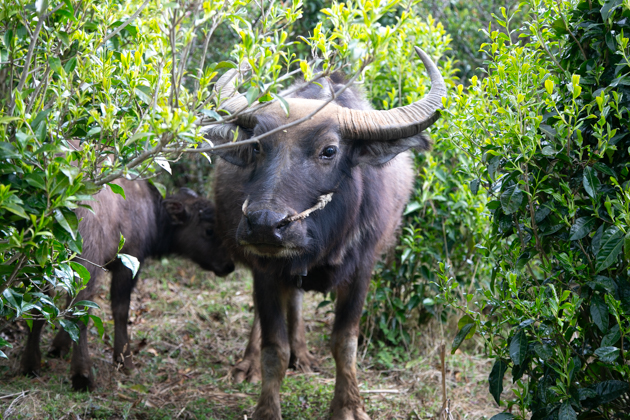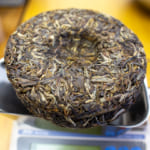- HOME >
- Origin of Tea
In Search of Wild Tea: Exploring Mountain Villages in Southwest Lincang, Yunnan
- [2024.04.28] Posted By Akira Hojo

We are currently sourcing tea in the southwestern part of Lincang City, Yunnan Province. One of the crucial products for us is wild tea. While tea processing is important, securing the raw materials poses the biggest challenge.
Recently, we received information about a new location where wild tea supposedly grows. To verify this, we visited the site in person to survey the actual growing condition of the wild tea trees.
Visiting a mountain village at an altitude of 2200 meters.
The village we visited this time is located in the southwestern part of Lincang City, Yunnan Province. Situated at an altitude of 2200 meters, this village is at an elevation that wild tea prefers, so we had high expectations.

In Yunnan Province, wild tea is commonly the mountain tea known as Camellia taliensis, a closely related species to the more familiar Camellia sinensis. This tea has a preference for sub-alpine zones and is typically found in areas with elevations ranging from 2200m to 2400m.
Cultivated Wild Tea
Upon arriving at the village, we met with the local villagers and proceeded to hike uphill for about an hour. There, we found a garden of Camellia taliensis. According to the villagers, these tea trees were unearthed from the mountains by themselves or their ancestors and planted on their own land.


Being isolated from other common agricultural plants such as potatoes, wheats, maize and walnuts, there’s absolutely no concern about pesticide or herbicide drift. However, from our perspective, we might question, “But isn’t that tea not truly wild?”
Yet, in reality, people in Yunnan Province don’t often differentiate between truly wild tea and tea transplanted from the wild. In Japan, for instance, there are cases where cultivated wild vegetables sprouts are sold as “mountain vegetables,” so it’s somewhat akin to that sensation.

If the tea trees are dug up from the deep forest of the mountains and replanted closer to the villages, it’s still better, but recently, Camellia taliensis has been planted everywhere and they are all called wild tea.
Even if you say “Camellia taliensis” to the people of Yunnan Province, most of them won’t understand. For them, mountain tea species equals wild tea.
In reality, whether the tea is truly wild or artificially cultivated wild species isn’t as important, as Camellia taliensis tea is being circulated as “wild tea”. From my experience, majority of the “wild tea” sold in the market refers to cultivated Camelia taliensis, either naturally cultivated wild tea gardens or artificially cultivated wild species of Camellia taliensis.

Camellia taliensis saplings planted in fields.
The value of wild tea comes from its natural ecosystem.
While exploring the Camellia taliensis tea gardens, I encountered grazing cows. Strangely, the cows showed no interest in the tea leaves and instead grazed on the undergrowth. In a way, it was a blessing for the tea farmers.
However, cow dung was scattered throughout the tea gardens, indicating unintentional but regular fertilization. Even with wild tea trees unearthed from the mountains, once cultivated around human settlements, the wild tea trees begin to be influenced by livestock and other factors, leading to a taste generally lighter than that of mountain-grown tea, lacking the lingering aftertaste characteristic of wild tea.


In the search for wild tea, such results are quite common. However, by persisting and continuing to explore, one may encounter unexpectedly excellent wild teas. At our store, we often look into the growing environment and the ecosystem of the wild tea trees, and it has to be the independent trees found in the nature.
Related Articles
How to get the latest update on HOJO?
1. Follow Twitter, 2. Click "Like" on Facebook, and 3. Subscribe in newsletter. You can have the latest tea news from HOJO.
 Subscribe the Newsletter to enjoy the privileges
Subscribe the Newsletter to enjoy the privileges- You may receive a free sample upon purchase, or you may have the priority to purchase special products. So please remember to subscribe our newsletter as well as the social network.
- New Arrival of Akitsu Mumyoi and Nosaka Rough Clay Teapot
- A wide selection of teaware by Watanabe Tozo, a Sado-based artist of Mumyoi-yaki, has just arrived. This time, …
- Mang Fei Ripe Pu-erh Tea 2023 – Small-Batch Production from a Renowned Region
- Mang Fei Ripe Pu-erh Tea 2023 is now available. This is one of the highest-quality ripe pu-erh teas among our …
NEW ARTICLES
 Development of Firewood Roasted Hojicha Using Naturally Grown Tea from Yunnan
Development of Firewood Roasted Hojicha Using Naturally Grown Tea from Yunnan- We are currently staying in Yunnan Province for tea production. As the season nears its end, tea trees with pa …
 Exploring the Food Culture of Yunnan: Where Minority and Sichuan Cuisines Meet
Exploring the Food Culture of Yunnan: Where Minority and Sichuan Cuisines Meet- We are currently staying long-term in Yunnan Province for spring tea production. On rainy days or when there i …
 New Arrival of Akitsu Mumyoi and Nosaka Rough Clay Teapot
New Arrival of Akitsu Mumyoi and Nosaka Rough Clay Teapot- A wide selection of teaware by Watanabe Tozo, a Sado-based artist of Mumyoi-yaki, has just arrived. This time, …
 Managing Yunnan White Tea — Insights from the Field
Managing Yunnan White Tea — Insights from the Field- Since March 25, we have been in Yunnan Province, fully engaged in the production of white tea. In this column, …
 Mang Fei Ripe Pu-erh Tea 2023 – Small-Batch Production from a Renowned Region
Mang Fei Ripe Pu-erh Tea 2023 – Small-Batch Production from a Renowned Region- Mang Fei Ripe Pu-erh Tea 2023 is now available. This is one of the highest-quality ripe pu-erh teas among our …
 Yunnan Tea Trends 2025: Insights from the Fields
Yunnan Tea Trends 2025: Insights from the Fields- Since March 25, we have been in Yunnan Province. We will stay here until May to conduct tea production, packin …
 Why Do Some Teas Taste Astringent? Exploring the Causes and Mechanisms of Astringency
Why Do Some Teas Taste Astringent? Exploring the Causes and Mechanisms of Astringency- Tea can range from having no noticeable astringency to possessing a very strong one. What causes this astringe …
 The Impact of Heat Sources on Tea Flavor
The Impact of Heat Sources on Tea Flavor- It is widely recognized that the material of a kettle plays an important role in shaping the taste of water fo …
 New Release of Tang Li Shan Ripe Pu-erh Tea 2023
New Release of Tang Li Shan Ripe Pu-erh Tea 2023- We have released the 2023 edition of Tang Li Shan Ripe Pu-erh Tea. Tang Li Shan refers to a mountain located o …
 The New Release of Dong Shan Raw Pu-erh Tea 2023 and Jasmine Silver Needle
The New Release of Dong Shan Raw Pu-erh Tea 2023 and Jasmine Silver Needle- We have released Dong Shan Raw Pu-erh Tea 2023 and Jasmine Silver Needle. Dong Shan Raw Pu-erh Tea 2023 We hav …
Category
- New Arrival at HOJO Online Shop
- Featured Articles
- Newsletter
- Types of Tea
- Origin of Tea
- Teapot and Tea Equipment
- Tea Column
- How to enjoy tea
- Tea Processing
- How to choose quality tea
- Tea constituents and functional effect
- Safety of Tea
- Foods
- Tea Business Operation
- Hobby and Outdoor Activity
- Ranking of Tea
- Video
- FAQ
- Media Release
Profile

- AKIRA HOJO
- I invite you to experience my tea selections.I was born in Nagano, Japan. In university, I studied agricultural chemistry, and I have the master degree in food science. I worked in Japanese food industry for 10 years. I involved in R&D, QC and QA. As a factory manager, I implemented ISO9000 series and managed the factory.
- The Art of Tea Magazine
- We posted the article on “The Art of Tea Magazine No.9, the magazine is published in Taiwan. We featured …
- New Straits Times
- The Malaysian National Newspaper, New Straits Times featured HOJO Tea on 17-Oct-2007.
Shop Info

Address:Lot No. T-215, 3rd Floor, The Gardens Mall, Mid Valley City, Lingkaran Syed Putra, 59200 Kuala Lumpur
Tel: +603-2287-4537
Business Hour: 10am to 10pm














